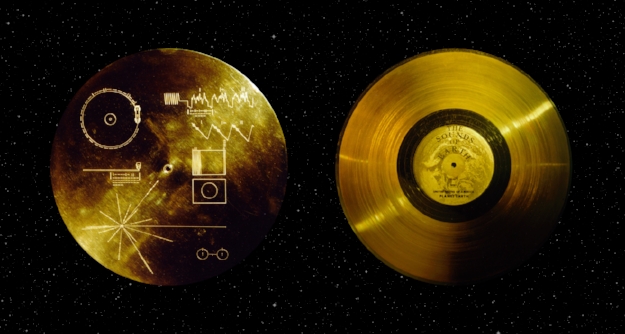A reminder about probably the coolest thing that we humans have ever done
The Golden Record. Credit: NASA
"4 billion years from now, when our sun turns into a red giant, Voyager is still going to be trucking out there through the stars. We'll still be out there." - Candy Hansen-Koharcheck
One time, we put a golden record on a spaceship and sent it off to interstellar space. This was part of a bigger mission, originally called the Voyager program.
Long after our sun burns out and we all perish, this golden record - which serves as the soundtrack of humankind - will be the last surviving evidence of our existence.
Some quick facts about the Voyager program:
- In 1977, we sent two spacecraft, Voyager 1 and Voyager 2, out into space on a mission to explore Jupiter and Saturn. The spacecraft were built to last five years.
- They did a really good job with the Jupiter and Saturn thing, so the mission was extended. Voyager 1 was sent on a direct trajectory to the outer limits of our solar system and eventually interstellar space, while Voyager 2 was tasked with making a couple pitstops to both Uranus and Neptune, before following suit with Voyager 1.
- Between the two of them, they were able to capture and transmit countless data regarding our systems's largest planets and their respective moons. They were also able to send back some super snazzy photos.
- Before leaving our solar system, Voyager 1 turned around to take a portrait of us and our neighbors. Scientifically, there was no reasoning behind this detour, but Carl Sagan insisted that it be done. Now we have these:
Credit: NASA
- And this:
- After 40 years, both Voyager spacecraft are still out there, traveling farther than any man-made object ever has, exploring the unknown beyond our Sun's domain.
- I haven't gotten to the best part.
The Golden Record
The Voyager program was designed to be more than a mission of exploration. In the unlikely event that either of these spacecraft were to encounter intelligent, extraterrestrial life, we included a golden phonograph record on each. Here's what the records contain:
- 115 images of our world and its various inhabitants
- 90 minutes of music from different times and cultures, including "Johnny B. Goode" by Chuck Berry
- A selection of natural sounds, such as wind, thunder, waves and birds
- Printed messages from President Carter and U.N. Secretary General Waldheim
- Spoken greetings in 55 languages
The English greeting was recorded by a group of children, who simply and innocently stated, "Hello from the children of planet Earth."
What was the point of all this?
Voyager 1 and Voyager 2 set out to explore, and to help us better understand our place in this endless arrangement of everything. And with them, encapsulated in these golden records, is the story of who we are, and what it means to be human.
To me, this incredible, ongoing Voyager mission is an extension of the same mission that we all embark on within ourselves every day. And the golden record? It wasn't made for some alien to randomly discover in a couple billion years from now. We made it for ourselves, to serve as a reminder of how special we are, and what's possible when we all work together toward something big.
Just like these spacecraft, we are all explorers lost in space - all in search of, well, something.


